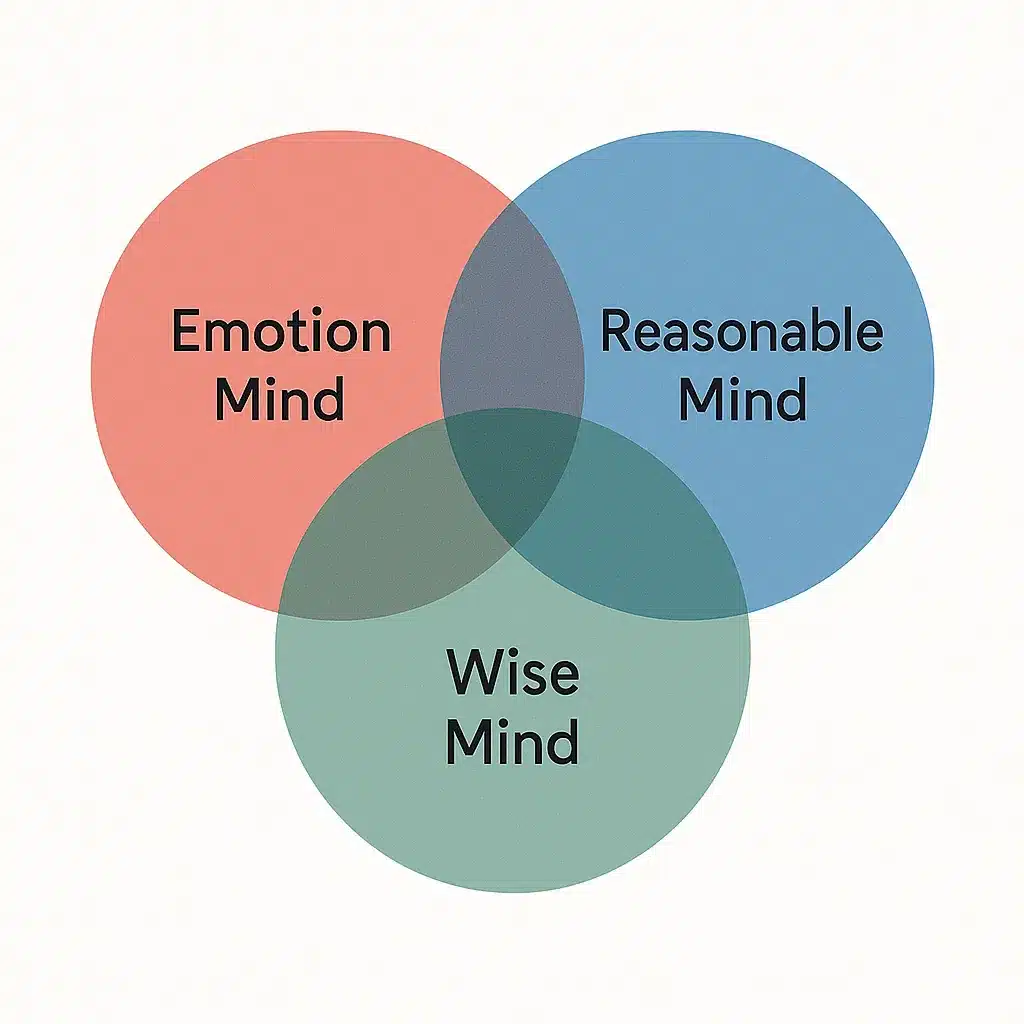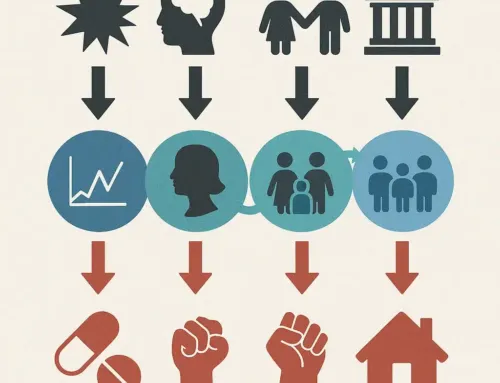
Approx. read time: 6.4 min.
Post: 1 Wise Mind in DBT: A Practical Guide to Balanced Decisions (with Tools)
🧠 What Is Wise Mind in DBT ?
Wise Mind is the centered state where you weave together emotional insight and rational thought. It’s not a compromise; it’s a synthesis. In Wise Mind, you notice feelings, consider facts, remember your values, and choose the most effective next step. DBT describes three “minds”: Emotion Mind, Reasonable Mind, and Wise Mind (the integration). Behavioral Tech Institute+1
In an emotionally reactive world, it’s easy to swing between intense feelings and cold logic. Wise Mind in DBT (Dialectical Behavior Therapy), created by Dr. Marsha Linehan, offers a grounded way to decide and act with clarity—integrating heart and head into one calm “inner knowing.” Behavioral Tech Institute-Wise Mind in DBT
🔥 Emotion Mind — Signs & Examples
When Emotion Mind drives, feelings take the wheel.
You might notice:
-
Impulsive actions and hot takes
-
Strong, fast reactions
-
Subjective interpretations
-
Decisions that swing with mood
Examples:
-
Snapping at a loved one during anger
-
Buying big when euphoric
-
Avoiding a needed conversation because of fear
🧮 Reasonable Mind — Signs & Examples – Wise Mind in DBT
Reasonable Mind is about data, logic, and plans.
You might notice:
-
Organized, analytical thinking
-
Emotional detachment
-
Structured problem-solving
-
Pros/cons, schedules, spreadsheets
Examples:
-
Building a detailed budget
-
Studying on a strict timetable
-
Weighing options without consulting feelings
Helpful—but alone, it can feel rigid or cold.
⚖️ Wise Mind — Where Emotion + Reason Meet
Wise Mind is calm, present, and values-aligned.
-
Aware of feelings and facts
-
Intuitive and quietly clear
-
Accepts reality and chooses how to respond
-
Responds rather than reacts
Examples:
-
Leaving a toxic relationship after calm reflection
-
Pausing during an argument, then speaking respectfully
-
Setting boundaries from self-respect, not spite
📊 Quick Comparison Table (Emotion vs. Reason vs. Wise)
| State | Primary Driver | Strength | Risk | Best Use |
|---|---|---|---|---|
| Emotion Mind | Feelings, urges | Energy, motivation | Impulsivity, bias | Creativity, empathy, signaling needs |
| Reasonable Mind | Facts, logic | Clarity, structure | Rigidity, detachment | Planning, analysis, safety decisions |
| Wise Mind | Integration | Balanced, effective | None inherent (requires practice) | Values-based choices under pressure |
🧘 Mindfulness: The Gateway (What/How Skills + Why It Works)
DBT uses mindfulness to notice which “mind” you’re in and to shift toward Wise Mind. The classic “What” skills are observe, describe, participate and the “How” skills are non-judgmentally, one-mindfully, effectively. Practicing these helps you access Wise Mind more reliably. PMC+1
Why it works (in brief): Mindfulness trains attention and emotion awareness, which improves regulation and reduces reactivity—creating space for integrated decisions. A 2022 review of mindfulness as taught in DBT explains how these skills enhance noticing state of mind and using Wise Mind to guide action. PMC
Tiny practice: 3 slow breaths; label what you see/feel/think (no judgment); choose one effective next step.
📝 Wise Mind Journal Prompts
Use three quick lenses, then synthesize:
-
Emotion Mind says: What am I feeling? What urge shows up?
-
Reasonable Mind says: What are the facts, risks, timelines?
-
Wise Mind knows: What aligns with my values and long-term goals?
Bonus: Write one effective behavior you’ll do in the next 10 minutes.
⏱️ A 2-Minute Access Protocol
Try this when you’re flooded or stuck:
-
Stop & Ground (20s): Plant feet. Notice 5 things you see, 4 feel, 3 hear.
-
Breathe (30s): In for 4, hold 1, out for 6. Repeat 3x.
-
Name the Mind (20s): “Right now I’m in Emotion/Reasonable Mind.”
-
Name the Value (20s): “In this situation I value ___ (e.g., respect, safety, honesty).”
-
Ask Wise Mind (30s): “What is the next effective step that honors my value and the facts?”
-
One Small Action (20s): Send the text you’d be proud to reread tomorrow; or delay the purchase; or step outside for 2 minutes.
🎬 Real-Life Scenarios (Work, Relationships, Self-Talk)
Friend conflict
-
Emotion: fire off a cutting text.
-
Reasonable: ice them out, analyze endlessly.
-
Wise: cool down, name hurt + facts, request a time to talk.
Job rejection
-
Emotion: “I’m a failure.”
-
Reasonable: apply everywhere, ignore feelings.
-
Wise: validate the sting, then plan 3 constructive actions (revise résumé, ask feedback, schedule two applications).
Relationship decision
-
Emotion: stay from fear or leave in rage.
-
Reasonable: spreadsheet of pros/cons only.
-
Wise: review patterns + values, choose a step that protects well-being and dignity.
🧱 Daily Micro-Skills to Build the Muscle
-
Name it to tame it: “This is Emotion Mind talking.”
-
One-mindfully: Do one thing at a time (eat, walk, write).
-
Two-sentence rule: When heated, limit your reply to two calm sentences.
-
Time-box feelings: 90 seconds of pure validation (“of course I feel ___”).
-
Tiny values reps: Ask, “What would Wise Mind do?” then take one small action.
🧩 Tailoring for ADHD/Autism + Common Traps
If you have ADHD or are autistic (and/or both):
-
Externalize Wise Mind: Use a sticky note or phone lock-screen with your top 3 values + “What would Wise Mind do?”
-
Reduce switching costs: Batch decisions; set 5-minute “cooling timers” before sending heated messages.
-
Sensory first aid: Noise-reduction, movement breaks, or dim lighting can lower arousal enough to access Wise Mind.
-
Scripts beat willpower: Keep 2–3 templated responses for conflict (“I want to understand. Can we talk at 6 pm?”).
Common traps & fixes
-
Trap: Treating Wise Mind like “numbness.”
Fix: Wise Mind feels clear, not cold—check for value alignment. -
Trap: Seeking perfect certainty before acting.
Fix: Choose the next effective step and review after. -
Trap: Over-journaling without behavior.
Fix: End every reflection with one observable action.
📚 Worksheets & Trusted Resources
If worksheets help, try a medically reviewed Wise Mind exercise and virtual coach for guided practice. Dialectical Behavior Therapy
For a concise overview of the What/How skills and their role in reaching Wise Mind, see a 2022 open-access paper on mindfulness in DBT. PMC
❓ FAQs
1) What is Wise Mind in DBT, in one sentence?
It’s the integrated state where you combine emotions, facts, and values to choose the most effective action.
2) Is Wise Mind the same as intuition?
Not exactly—intuition plus awareness of facts and values is closer; Wise Mind isn’t a hunch, it’s informed inner knowing.
3) How do I know I’m not just in Emotion Mind pretending it’s Wise Mind?
Check for facts, values, and calm—if you’re flooded or urgent, cool down, then re-ask Wise Mind.
4) How long does it take to learn?
Most people feel small wins in days or weeks with daily micro-practice; the skill deepens over time.
5) What DBT skills help me access Wise Mind?
Mindfulness “What/How” skills: observe, describe, participate; non-judgmentally, one-mindfully, effectively. PMC
6) Can I use Wise Mind at work?
Yes—pause, label the mind, restate the goal (e.g., clarity, safety), then choose one effective step (email draft, boundary, data check).
7) What if my Wise Mind gives me nothing?
Return to sensory grounding and values; if still blank, sleep on it or ask a trusted person for a fact-check.
8) Is DBT only for clinical issues?
No—DBT grew from clinical roots but its skills are widely used for everyday decision-making and relationships. Psychiatry Online
✅ Conclusion + Next Steps
Living from Wise Mind in DBT means choosing intention over impulse. It doesn’t silence feelings or overrule facts; it integrates them into effective, values-aligned action. Start small: practice the 2-minute protocol once today, then pick one micro-skill to repeat all week.
🔗 Sources & References
-
Behavioral Tech (Linehan Institute): Wisdom in DBT – Finding Wise Mind. Behavioral Tech Institute
-
Eeles J. Mindfulness as taught in DBT (open-access review, 2022). PMC
-
PsychiatryOnline: The Course and Evolution of DBT (overview). Psychiatry Online
-
DialecticalBehaviorTherapy.com: Wise Mind — medically reviewed exercise & worksheet. Dialectical Behavior Therapy









